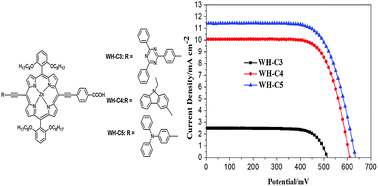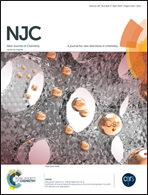The effect of porphyrins suspended with different electronegative moieties on the photovoltaic performance of monolithic porphyrin-sensitized solar cells with carbon counter electrodes
Abstract
Three D–π–A porphyrin sensitizers with different electronegative moieties (2,4,6-triphenyl-1,3,5-triazine, carbazole and triphenylamine) attached at the meso-position were designed and synthesized for monolithic dye-sensitized solar cells based on mesoscopic carbon counter electrodes. The effects of these different electronegative moieties on the photophysical, electrochemical and accordingly photovoltaic performance of the corresponding devices were investigated systematically. Electrochemical measurements indicate that the HOMO and LUMO energy levels could be tuned through the introduction of different electronegative groups onto the backbone of D–π–A porphyrin molecules. Current–voltage characteristics indicate that the Jsc and Voc of the DSSCs based on WH-C3, WH-C4 and WH-C5 increase as the electron-donating ability of their donors enhance in the order of WH-C3 < WH-C4 < WH-C5 and WH-C5-sensitized cells showed the best photovoltaic performance: a short circuit photocurrent density (Jsc) of 11.43 mA cm−2, an open circuit voltage (Voc) of 633.84 mV, and a fill factor (FF) of 0.69, corresponding to an overall conversion efficiency (η) of 5.00%.


 Please wait while we load your content...
Please wait while we load your content...